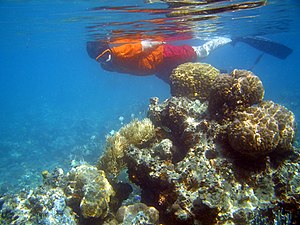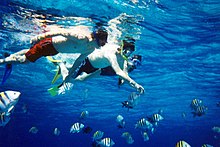Snorkeling

Snorkeling (British spelling: snorkelling) is the practice of swimming on or through a body of water while equipped with a diving mask, a shaped tube called a snorkel, and usually swimfins. In cooler waters, a wetsuit may also be worn. Use of this equipment allows the snorkeler to observe underwater attractions for extended periods of time with relatively little effort.
Snorkeling is a popular recreational activity, particularly at tropical resort and scuba diving locations. The primary appeal is the opportunity to observe underwater life in a natural setting without the complicated equipment and training required for scuba diving, and without the exhaled bubbles of scuba-diving equipment.
Snorkeling is also employed by scuba divers when on the surface, and search and rescue teams may snorkel as part of a water-based search. It is also a means to an end in popular sports such as underwater hockey, underwater ice hockey, underwater rugby and spearfishing.
The snorkel
A swimmer's snorkel is a tube typically about 30 centimeters long and with an inside diameter of between 1.5 and 2.5 centimeters, usually L- or J-shaped and fitted with a mouthpiece at the lower end, and constructed of rubber or plastic. It is used for breathing air from above the water surface when the wearer's mouth and nose are submerged. The snorkel usually has a piece of rubber that attaches the snorkel to the outside of the strap of the diving mask. An older technique is pushing the snorkel between the mask-strap and the head, but this practice increases the chances the mask will leak.
The most common type of snorkel is a simple tube that is allowed to flood when underwater. The snorkeler expels water from the snorkel either with a sharp exhalation on return to the surface (blast clearing) or by tilting the head back shortly before reaching the surface and exhaling until reaching or "breaking" the surface (displacement method) and facing forward again before inhaling the next breath. The displacement method expels water by displacing its presence in the snorkel with air; it is a more advanced technique that takes practice but clears the snorkel with much greater efficiency.

Some modern snorkels have a sump in the mouthpiece to allow a small volume of water to remain in the snorkel without being inhaled when the snorkeler breathes. Some also have a one-way output valve in the sump, which automatically drains the sump as it fills with water. A few snorkels have float-operated valves attached to the top end of the tube to keep water out when the snorkeler submerges, and more recent designs have a splash deflector on the top end that directs any water that splashes over the open tube to the outside of the tube, thereby keeping the user's mouth free from water.
Some snorkels used to be made with small "ping pong" balls in a cage mounted to the open end of the tube to prevent water ingress, but these are no longer sold nor recommended to be used since they are considered hazardous to the snorkeler. Similarly, diving masks with a snorkel built into them are considered unsafe and obsolete.
The optimum design length of the snorkel tube is at most 40 centimetres (about 16 inches). A longer tube would not allow breathing when snorkelling deeper, since it would place the lungs in deeper water where the surrounding water pressure is higher. The lungs would then be unable to inflate when the snorkeler inhales, because the muscles that expand the lungs are not strong enough to operate against the higher pressure.[1] Snorkels also create what is called "dead air space" – when the user takes in a fresh breath, some of the previously exhaled air remains in the snorkel and is recycled into the lungs, reducing breathing efficiency and causing hypercapnia, a build up of carbon dioxide in the blood. The greater the volume in the device, the more this problem is exacerbated.
Advances in snorkeling technology have helped to alleviate CO₂ retention. Mark R. Johnson MD has invented a snorkel that features what he calls "Kadence Technology," which separates the inhalation and exhalation paths in the snorkel using one-way valves to direct air flow. The exhalation valve places a resistance into the exhalation path of the snorkel, which introduces a small back pressure, resulting in a steadier breathing pattern and more natural lung volumes. The inhalation path is blocked when submerged, allowing the snorkeler to inhale on return to the surface without having to purge the snorkel first.[2]
The dive mask
Snorkelers normally wear the same kind of mask as those worn by scuba divers. By creating an airspace, the mask enables the snorkeler to see clearly underwater. All scuba diving masks consist of the lenses also known as a faceplate, a comfortable skirt, which also encloses the nose, and a head strap. There are different styles and shapes. These range from oval shaped models to lower internal volume masks and may be made from different materials; common choices are silicone and rubber.
The practice of snorkeling

Although donning a mask and snorkel and swimming in any body of water would technically constitute "snorkeling," by and large it is generally accepted that a "snorkeler" would don such gear and practice such activity within the vicinity of a reef, wreck, or other submerged objects, either to observe aquatic organisms including fish, algae, etc. or to look at rock formations. Being non-competitive, snorkeling is considered more a leisure activity than a sport.
Snorkeling requires no special training, only the ability to swim and to breathe through the snorkel. However, for safety reasons, instruction and orientation from a fellow "experienced" snorkeler, tour guide, dive shop, or equipment-rental shop is recommended. Instruction generally covers equipment usage, basic safety, what to look for, and what to look out for, and conservation instructions (fragile organisms such as coral are easily damaged by divers and snorkelers). As with scuba-diving it is always recommended that one not snorkel alone, but rather with a "buddy", a guide or a tour group.
Some commercial snorkeling locations require snorkelers to wear an inflatable vest, similar to a personal flotation device. They are usually bright yellow or orange and have a device that allows users to inflate or deflate the device to adjust their buoyancy. However these devices hinder and prevent a snorkeler from free diving to any depth. Especially in cooler water, a wetsuit of appropriate thickness and coverage may be worn; wetsuits do provide some buoyancy without as much resistance to submersion. In the tropics, snorkelers (especially those with pale skin) often wear a rashguard or a shirt and/or board shorts in order to help protect the skin of the back and upper legs against sunburn.
Experienced snorkelers often start to investigate amateur free-diving, which should be preceded by at least some training from a dive instructor or experienced free-diver.
Safety precautions
The greatest danger to snorkelers are small inshore and leisure crafts such as jet skis, speed boats and the like. A snorkeler is often submerged in the water with only the tube visible above. Since these crafts can ply the same areas snorkelers visit, the chance for accidental collision exists. Sailboats and windsurfers are especially worrisome as their quiet propulsion systems means the snorkeler may be unaware of their presence, unlike any motor-driven craft, as sound travels farther underwater. A snorkeler may surface under one and/or be struck by such vessels. Few places demarcate small craft areas from snorkelers, unlike for regular bathers who may have areas marked by buoys. Snorkelers may therefore choose to wear bright or highly reflective colors/outfits and/or to employ dive flags to ease being spotted by boaters and others.
Snorkelers' backs can be exposed to the sun for extended periods and can burn badly (even if slightly submerged), without being noticed. Wearing appropriate covering such as a "rash guard" (in warmer waters), a t-shirt, a wetsuit and/or sunblock will mitigate the risk of sunburn.
Dehydration is another concern. Hydrating well before going in is recommended, especially if one intends to snorkel for several hours. Proper hydration also prevents cramps.
Snorkelers can experience hyperventilation, which can lead in turn to “shallow water blackout″; snorkeling with a buddy (and being aware of the buddy's condition at all times) can help avoid this situation.
When snorkeling on or near coral reefs, care must be exercised to avoid contact with the delicate (and sometimes sharp and/or stinging) coral and its poisonous inhabitants, usually via protective gloves and by being careful of one's environment. Booties and surf shoes are especially useful as they allow trekking over reefs exposed by low tide, to drop offs or deeper waters of the outer reef.
Also, for ecological reasons, contact with coral always should be avoided because even boulder corals are fragile. A soft touch can cause decades worth of growth to be undone in mere seconds, and the coral may never recover.
Snorkeling locations


Snorkeling is possible in almost any body of water, but snorkelers are most likely to be found in locations where there are minimal waves, warm water, and something particularly interesting to see near the surface.
Generally shallow reefs ranging from sea level to 1 to 4 meters (3 to 12 feet) are favored by snorkelers. Deeper reefs are also good, but repeated breath holding to dive to those depths limit the number of practitioners and raises the bar on fitness and skill level.
Variants and related activities
- Bog snorkelling: An individual sport, popular in the United Kingdom and Australia.
- Free-diving: Any form of diving without breathing apparatus, but often referring to competitive apnea as a sport.
- Scuba diving: A form of untethered diving using a self contained portable breathing apparatus, frequently as a pastime.
- Snuba: Trade name for an underwater swimming system using air supplied from the surface.
- Spearfishing: Fishing with a spear often with snorkelling equipment, either for competitive sport or to obtain food.
- Underwater hockey: A competitive team-sport played in swimming pools using snorkelling equipment, sticks and a puck.
- Underwater rugby: A competitive team-sport played in deeper swimming pools using snorkelling equipment, baskets and a ball.
See also
References
This article includes a list of general references, but it lacks sufficient corresponding inline citations. (December 2007) |
- The British Sub-Aqua Club, and Holbrook, Mike. Snorkelling for All. London: Ebury, 2001. ISBN 0-09-188304-0.
External links
- British Sub-Aqua Club site on snorkeling
- National Parks Conservation Association page on snorkeling
- US patent 1901219, Joseph L. Belcher, "Breathing apparatus", issued 1932-07-30 Earliest known patent for snorkel.
